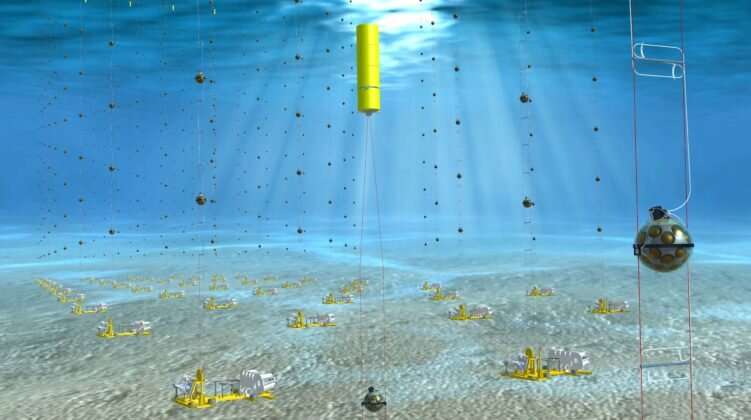Scientists use giant telescope on sea floor to study rays from space

Curtin University researchers are part of an international project that will use a huge underwater neutrino telescope at the bottom of the Mediterranean Sea to help explain some of the most powerful and mysterious events in the universe.
Located at two sites at depths of up to 3500m, the KM3NeT telescope will occupy more than a cubic kilometre of water, and will comprise of hundreds of vertical detection lines anchored to the seabed and held in place by buoys when complete.
Dr. Clancy James, from the Curtin Institute of Radio Astronomy and the International Centre for Radio Astronomy Research (ICRAR), said such a huge volume of water was required to surround the instruments because neutrinos were otherwise difficult to detect.
"Neutrinos very rarely interact, however when a neutrino hits water it generates light, which the KM3NeT telescope is able to detect," Dr. James said.
"The underwater telescope is bombarded by millions of different particles, but only neutrinos can pass through the Earth to reach the detector from below so, unlike normal telescopes, it looks down through the Earth at the same sky viewed by upward-facing telescopes in Australia."
Dr. James said KM3NeT needed to be incredibly sensitive because the light detected from neutrino interactions was about as faint as the light from a lightbulb in Sydney as seen from Perth.
"Each line has 18 modules equipped with light sensors along its length and, in the darkness of the deep ocean, these sensors register the faint flashes of a special light that signals the interaction of neutrinos with the seawater," Dr. James said.
"This project will help us answer some of the major questions around particle physics and the nature of our universe, potentially ushering in a new era in neutrino astronomy."
Curtin University formally joined the project in March 2019 and will use radio telescopes such as the Murchison Widefield Array to study the origins of neutrinos seen by KM3NeT.
Provided by Curtin University



















